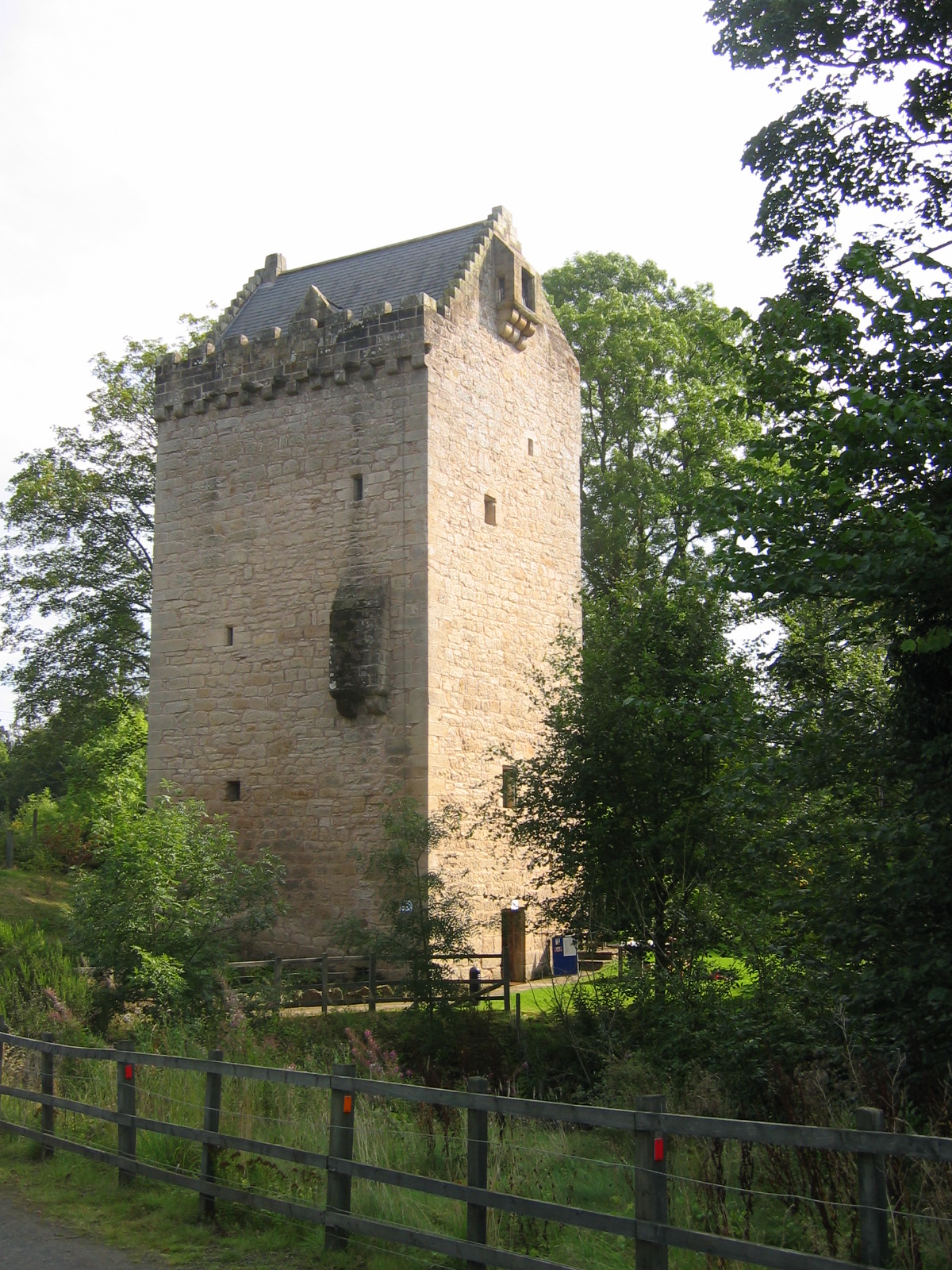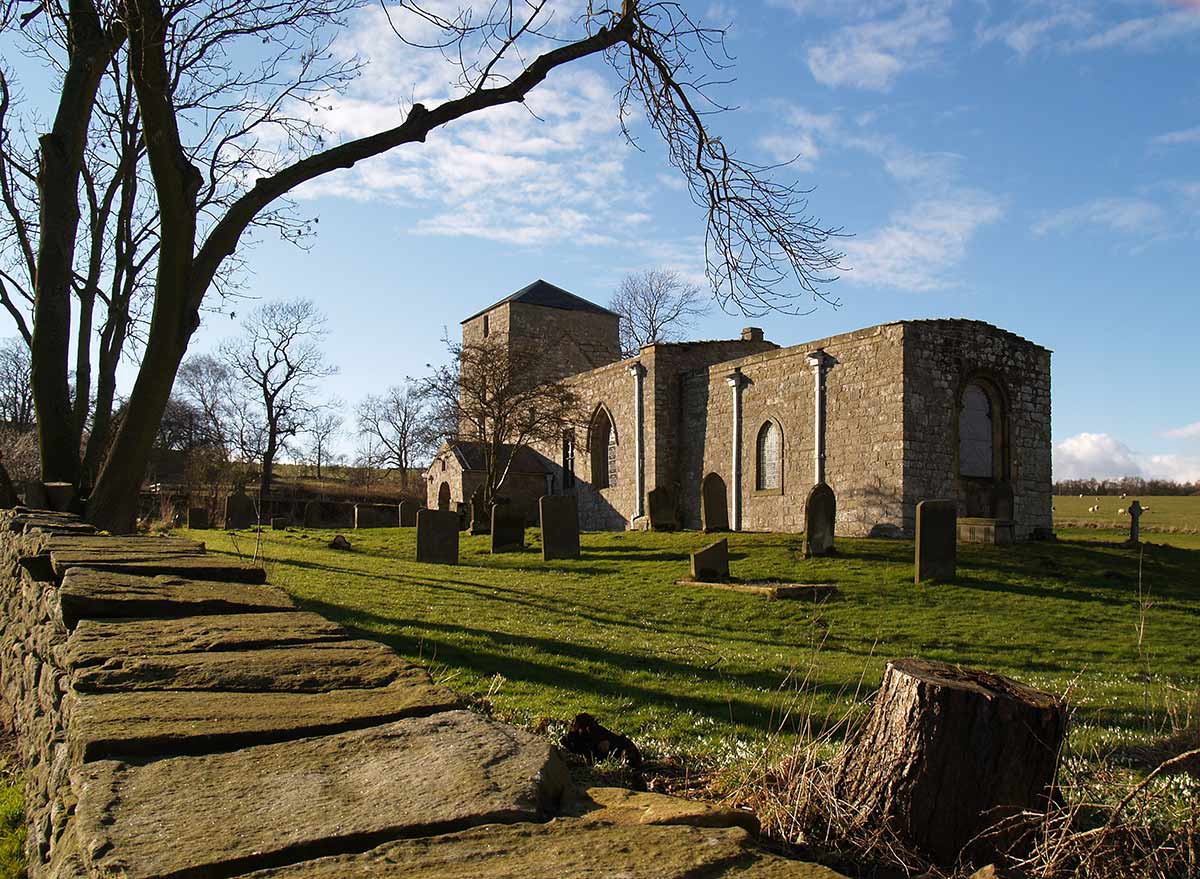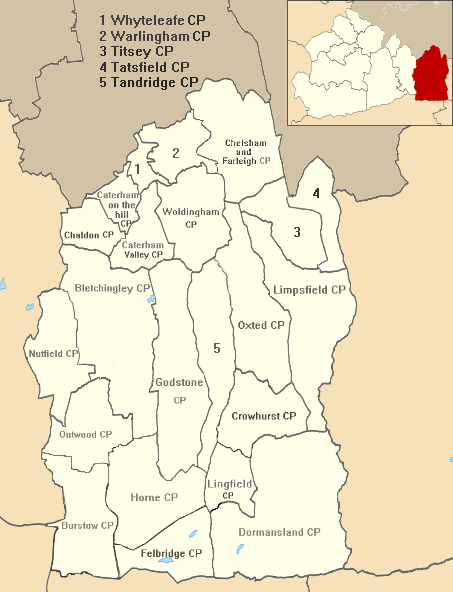|
Lemmington Hall
Lemmington Hall is an 18th-century country mansion incorporating a 15th-century tower house, situated near Edlingham, Northumberland, England. It is a Grade II* listed building. The original tower house built for the Beadnall family in the early 15th century was a four-storey construction which was reduced in height in the 17th century when Nicholas Fenwick (Mayor of Newcastle 1720) converted the building into a country house. Despite substantial alterations and improvements by architect William Newton in the late 18th century, the property had become a roofless ruin by the end of the 19th century. It was completely restored by Sir Stephen Aitchison (see Aitchison baronets), who acquired the ruinous property in 1913. In 1927 Aitchison bought an column, designed by Sir John Soane dedicated to the memory of members of the Evelyn family of Felbridge, Surrey, which he dismantled and re-erected in the grounds at Lemmington. In 1825 the property was acquired by William Pawson of S ... [...More Info...] [...Related Items...] OR: [Wikipedia] [Google] [Baidu] |
Northumberland
Northumberland () is a ceremonial counties of England, county in Northern England, one of two counties in England which border with Scotland. Notable landmarks in the county include Alnwick Castle, Bamburgh Castle, Hadrian's Wall and Hexham Abbey. It is bordered by land on three sides; by the Scottish Borders, Scottish Borders region to the north, County Durham and Tyne and Wear to the south, and Cumbria to the west. The fourth side is the North Sea, with a stretch of coastline to the east. A predominantly rural area, rural county with a landscape of moorland and farmland, a large area is part of Northumberland National Park. The area has been the site of a number of historic Anglo-Scottish wars, battles with Scotland. Name The name of Northumberland is recorded as ''norð hẏmbra land'' in the Anglo-Saxon Chronicle, meaning "the land north of the Humber". The name of the kingdom of ''Northumbria'' derives from the Old English meaning "the people or province north of th ... [...More Info...] [...Related Items...] OR: [Wikipedia] [Google] [Baidu] |
Ordnance Survey National Grid
The Ordnance Survey National Grid reference system (OSGB) (also known as British National Grid (BNG)) is a system of geographic grid references used in Great Britain, distinct from latitude and longitude. The Ordnance Survey (OS) devised the national grid reference system, and it is heavily used in their survey data, and in maps based on those surveys, whether published by the Ordnance Survey or by commercial map producers. Grid references are also commonly quoted in other publications and data sources, such as guide books and government planning documents. A number of different systems exist that can provide grid references for locations within the British Isles: this article describes the system created solely for Great Britain and its outlying islands (including the Isle of Man); the Irish grid reference system was a similar system created by the Ordnance Survey of Ireland and the Ordnance Survey of Northern Ireland for the island of Ireland. The Universal Transverse ... [...More Info...] [...Related Items...] OR: [Wikipedia] [Google] [Baidu] |
Tower House
A tower house is a particular type of stone structure, built for defensive purposes as well as habitation. Tower houses began to appear in the Middle Ages, especially in mountainous or limited access areas, in order to command and defend strategic points with reduced forces. At the same time, they were also used as an aristocrat's residence, around which a castle town was often constructed. Europe After their initial appearance in Ireland, Scotland, the Frisian lands, Basque Country and England during the High Middle Ages, tower houses were also built in other parts of western Europe, especially in parts of France and Italy. In Italian medieval communes, urban ''palazzi'' with a very tall tower were increasingly built by the local highly competitive patrician families as power centres during times of internal strife. Most north Italian cities had a number of these by the end of the Middles Ages, but few now remain, notably two towers in Bologna, twenty towers in Pa ... [...More Info...] [...Related Items...] OR: [Wikipedia] [Google] [Baidu] |
Edlingham
Edlingham is a small village and civil parish in Northumberland in the north of England. At the 2001 census it had a population of 196, which had reduced slightly to 191 at the 2011 Census. The road to Alnwick passes close by the village and the town of Rothbury is about away. The name ''Edlingham'' means ''The home of Eadwulf'' in Anglo-Saxon. Its recorded history goes back as far as 737 when King Coelwulf gave Edlingham and three other royal Northumbrian villages to Cuthbert. Landmarks St. John the Baptist's Church dates largely from the 11th and 12th centuries, with a remarkable fortified tower added c.1300. britishlistedbuildings.co.uk. Retrieved 15 September 2011. Situated close to the church, |
England
England is a country that is part of the United Kingdom. It shares land borders with Wales to its west and Scotland to its north. The Irish Sea lies northwest and the Celtic Sea to the southwest. It is separated from continental Europe by the North Sea to the east and the English Channel to the south. The country covers five-eighths of the island of Great Britain, which lies in the North Atlantic, and includes over 100 smaller islands, such as the Isles of Scilly and the Isle of Wight. The area now called England was first inhabited by modern humans during the Upper Paleolithic period, but takes its name from the Angles, a Germanic tribe deriving its name from the Anglia peninsula, who settled during the 5th and 6th centuries. England became a unified state in the 10th century and has had a significant cultural and legal impact on the wider world since the Age of Discovery, which began during the 15th century. The English language, the Anglican Church, and Eng ... [...More Info...] [...Related Items...] OR: [Wikipedia] [Google] [Baidu] |
Grade II* Listed Building
In the United Kingdom, a listed building or listed structure is one that has been placed on one of the four statutory lists maintained by Historic England in England, Historic Environment Scotland in Scotland, in Wales, and the Northern Ireland Environment Agency in Northern Ireland. The term has also been used in the Republic of Ireland, where buildings are protected under the Planning and Development Act 2000. The statutory term in Ireland is "protected structure". A listed building may not be demolished, extended, or altered without special permission from the local planning authority, which typically consults the relevant central government agency, particularly for significant alterations to the more notable listed buildings. In England and Wales, a national amenity society must be notified of any work to a listed building which involves any element of demolition. Exemption from secular listed building control is provided for some buildings in current use for worship, ... [...More Info...] [...Related Items...] OR: [Wikipedia] [Google] [Baidu] |
Nicholas Fenwick
Nicholas Fenwick (c. 1693–1752) of Pilgrim Street, Newcastle-upon-Tyne, and Lemington, Northumberland was a British Tory politician who sat in the House of Commons from 1727 to 1747. Fenwick was the eldest son of Robert Fenwick, merchant and mayor of Newcastle in 1708, and Isabella Ellison, daughter of Cuthbert Ellison of Hebburn, county Durham. He married Elizabeth Baker, daughter of George Baker of Crook, county Durham on 21 October 1713. She died in March 1715. He married as his second wife on 9 May 1716, Elizabeth Clavering, daughter of Sir James Clavering, 4th Baronet, of Axwell, county Durham. By her, he acquired Lemington, in Alnwick, where he practised forestry. He received a gold medal from the Society of Arts for his forestry work. Fenwick was admitted to the Merchant Adventurers Company in 1712. He was Mayor of Newcastle in 1726. At the 1727 British general election he was returned as Tory Member of Parliament for Newcastle-upon-Tyne. He voted against the Adm ... [...More Info...] [...Related Items...] OR: [Wikipedia] [Google] [Baidu] |
William Newton (architect, 1730–1798)
William Newton (1730–1798) was an English architect who worked mainly in Newcastle upon Tyne and Northumberland. His work shows a conventional but elegant classical style, influenced by Adam and Paine, and with a strong Palladian feel typical of late 18th century architecture. Most of his buildings are stately homes in rural Northumberland, but he also created some interesting public works in Newcastle: The Assembly Rooms, St Anne's Church, the refaced Guildhall, and elegant private housing in Charlotte Square. He was the son of Robert Newton, a builder. He married Dorothy Bell and lived for 28 years at 1, Charlotte Square, Newcastle. His big break came when he was appointed architect for The Assembly Rooms in Newcastle in 1774; as a result he became favoured by the Northumbrian elite. He has been described as 'the first truly Nothumbrian architect'. His work includes:- * The Infirmary, Newcastle 1751-2 (demolished 1954) * Capheaton Hall (North front) 1758 * St Mungo, S ... [...More Info...] [...Related Items...] OR: [Wikipedia] [Google] [Baidu] |
Aitchison Baronets
The Aitchison Baronetcy, of Lemmington in the county of Northumberland, is a title in the Baronetage of the United Kingdom. It was created on 31 January 1938 for Sir Stephen Aitchison, of Lemmington Hall, Northumberland, a Justice of the Peace for the city and county of Newcastle upon Tyne and for Northumberland. Aitchison baronets, of Lemmington (1938) * Sir Stephen Aitchison, 1st Baronet (1863–1942) *Sir Walter de Lancy Aitchison, 2nd Baronet (1892–1953) *Sir Stephen Charles de Lancy Aitchison, 3rd Baronet (1923–1958) *Sir Charles Walter de Lancy Aitchison, 4th Baronet (born 1951) :The heir apparent An heir apparent, often shortened to heir, is a person who is first in an order of succession and cannot be displaced from inheriting by the birth of another person; a person who is first in the order of succession but can be displaced by the b ... is Rory Edward de Lancey Aitchison (born 1986) Notes References *Kidd, Charles, Williamson, David (editors). ''Debrett ... [...More Info...] [...Related Items...] OR: [Wikipedia] [Google] [Baidu] |
Sir John Soane
Sir John Soane (; né Soan; 10 September 1753 – 20 January 1837) was an English architect who specialised in the Neo-Classical style. The son of a bricklayer, he rose to the top of his profession, becoming professor of architecture at the Royal Academy and an official architect to the Office of Works. He received a knighthood in 1831. His best-known work was the Bank of England (his work there is largely destroyed), a building which had a widespread effect on commercial architecture. He also designed Dulwich Picture Gallery, which, with its top-lit galleries, was a major influence on the planning of subsequent art galleries and museums. His main legacy is the eponymous museum in Lincoln's Inn Fields in his former home and office, designed to display the art works and architectural artefacts that he collected during his lifetime. The museum is described in the ''Oxford Dictionary of Architecture'' as "one of the most complex, intricate, and ingenious series of interior ... [...More Info...] [...Related Items...] OR: [Wikipedia] [Google] [Baidu] |
Felbridge
__NOTOC__ Felbridge is a village and civil parish in the Tandridge district of Surrey with a playing field within its focal area, narrowly in West Sussex. Felbridge village forms a contiguous settlement with East Grinstead and had 829 homes and households at the time of the 2011 census. Domewood is part of Felbridge civil parish, which was created in 1953. History Early history Until shortly after 1911, the area was part of the parish of Horne. No reference appears to a separate settlement being here in the Domesday Book of 1086. Post Reformation James son of Edward Evelyn succeeded to the manors of Hedgecourt (and smaller carucate of Covelingeley) in the parish of Horne and the estate of Felbridge in 1751. Julia Evelyn Medley, his granddaughter by his first wife, who had married Charles Jenkinson, 3rd Earl of Liverpool held this estate, after James's Evelyn wife's death, as late as 1841. By 1911, whereabouts it lost much of its land, amid the economic change and social re ... [...More Info...] [...Related Items...] OR: [Wikipedia] [Google] [Baidu] |
Shawdon Hall
Shawdon Hall is a privately owned 18th-century country house located between Bolton and Hedgeley, near Alnwick, Northumberland, in North East England. It is a Grade II* listed building. History The manor of Shawdon was owned by Thomas Lilburn, a member of the House of Lilburn, in the 15th century. A survey of 1541 disclosed a 'tower in measurable good reparation' in the ownership of Cuthbert Proctor. John Proctor sold the estate in 1705. The new owner William Hargrave (who was High Sheriff of Northumberland in 1783) demolished the old house and replaced it in 1779 with a new mansion, probably designed by architect William Newton. The house is of two stories with a seven-bay entrance front, the central three bays being pilastered and with a pediment bearing the 1817 arms of Pawson. Keys to the Past Follo ... [...More Info...] [...Related Items...] OR: [Wikipedia] [Google] [Baidu] |








